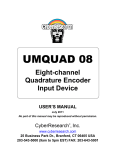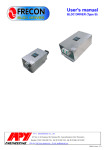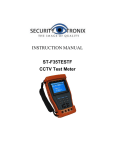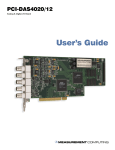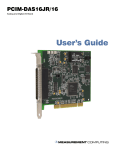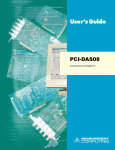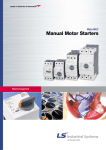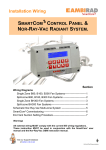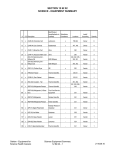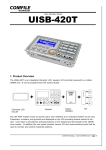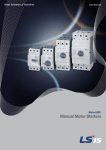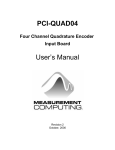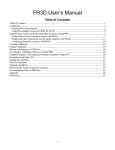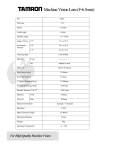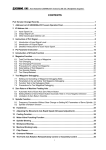Download USB-QUAD08 User`s Guide
Transcript
USB-QUAD08 Eight-channel Quadrature Encoder Input Device User's Guide Document Revision 3 May 2012 © Copyright 2012 Your new Measurement Computing product comes with a fantastic extra — Management committed to your satisfaction! Thank you for choosing a Measurement Computing product—and congratulations! You own the finest, and you can now enjoy the protection of the most comprehensive warranties and unmatched phone tech support. It’s the embodiment of our mission: To provide data acquisition hardware and software that will save time and save money. Simple installations minimize the time between setting up your system and actually making measurements. We offer quick and simple access to outstanding live FREE technical support to help integrate MCC products into a DAQ system. Limited Lifetime Warranty: Most MCC products are covered by a limited lifetime warranty against defects in materials or workmanship for the life of the product, to the original purchaser, unless otherwise noted. Any products found to be defective in material or workmanship will be repaired, replaced with same or similar device, or refunded at MCC’s discretion. For specific information, please refer to the terms and conditions of sale. Harsh Environment Program: Any Measurement Computing product that is damaged due to misuse, or any reason, may be eligible for replacement with the same or similar device for 50% of the current list price. I/O boards face some harsh environments, some harsher than the boards are designed to withstand. Contact MCC to determine your product’s eligibility for this program. 30 Day Money-Back Guarantee: Any Measurement Computing Corporation product may be returned within 30 days of purchase for a full refund of the price paid for the product being returned. If you are not satisfied, or chose the wrong product by mistake, you do not have to keep it. These warranties are in lieu of all other warranties, expressed or implied, including any implied warranty of merchantability or fitness for a particular application. The remedies provided herein are the buyer’s sole and exclusive remedies. Neither Measurement Computing Corporation, nor its employees shall be liable for any direct or indirect, special, incidental or consequential damage arising from the use of its products, even if Measurement Computing Corporation has been notified in advance of the possibility of such damages. Trademark and Copyright Information Measurement Computing Corporation, InstaCal, Universal Library, and the Measurement Computing logo are either trademarks or registered trademarks of Measurement Computing Corporation. Refer to the Copyrights & Trademarks section on mccdaq.com/legal for more information about Measurement Computing trademarks. Other product and company names mentioned herein are trademarks or trade names of their respective companies. © 2012 Measurement Computing Corporation. All rights reserved. No part of this publication may be reproduced, stored in a retrieval system, or transmitted, in any form by any means, electronic, mechanical, by photocopying, recording, or otherwise without the prior written permission of Measurement Computing Corporation. Notice Measurement Computing Corporation does not authorize any Measurement Computing Corporation product for use in life support systems and/or devices without prior written consent from Measurement Computing Corporation. Life support devices/systems are devices or systems that, a) are intended for surgical implantation into the body, or b) support or sustain life and whose failure to perform can be reasonably expected to result in injury. Measurement Computing Corporation products are not designed with the components required, and are not subject to the testing required to ensure a level of reliability suitable for the treatment and diagnosis of people. HM USB-QUAD08.docx Table of Contents Preface About this User's Guide ....................................................................................................................... 5 What you will learn from this user's guide ......................................................................................................... 5 Conventions in this user's guide ......................................................................................................................... 5 Where to find more information ......................................................................................................................... 5 Chapter 1 Introducing the USB-QUAD08 ............................................................................................................. 6 Chapter 2 Installing the USB-QUAD08.................................................................................................................. 7 What comes with your USB-QUAD08 shipment? ............................................................................................. 7 Hardware .......................................................................................................................................................................... 7 Documentation .................................................................................................................................................................. 7 Optional components ........................................................................................................................................................ 7 Unpacking the USB-QUAD08 ........................................................................................................................... 7 Installing the software ........................................................................................................................................ 7 Configuring the channel input mode .................................................................................................................. 8 Installing the hardware ....................................................................................................................................... 8 Connecting the USB-QUAD08 to your system ................................................................................................................ 9 Signal connections .............................................................................................................................................. 9 Screw terminal pinout ......................................................................................................................................................10 37-pin connector pinout (J12 and J50) .............................................................................................................................12 Cables ..............................................................................................................................................................................13 Signal termination ............................................................................................................................................................14 DIN-rail mounting ...........................................................................................................................................................14 Connecting the USB-QUAD08 to an encoder .................................................................................................. 15 Chapter 3 Functional Details ...............................................................................................................................17 USB-QUAD08 block diagram .......................................................................................................................... 17 External components ........................................................................................................................................ 18 Screw terminals................................................................................................................................................................18 37-pin connectors (J12, J50) ............................................................................................................................................19 LED indicators .................................................................................................................................................................19 USB connector .................................................................................................................................................................19 Counter input modes ......................................................................................................................................... 19 Quadrature counter mode .................................................................................................................................................19 Totalize counter mode......................................................................................................................................................20 Period measurement mode ...............................................................................................................................................21 Pulse width measurement mode .......................................................................................................................................21 Synchronous/asynchronous scanning ............................................................................................................... 21 Synchronous scanning .....................................................................................................................................................21 Asynchronous scanning ...................................................................................................................................................22 Debounce mode ................................................................................................................................................ 22 Trigger after stable mode .................................................................................................................................................22 Trigger before stable mode ..............................................................................................................................................23 Debounce mode comparisons ..........................................................................................................................................24 Digital I/O ......................................................................................................................................................... 25 Digital input .....................................................................................................................................................................25 Digital output ...................................................................................................................................................................25 Terminal count output ......................................................................................................................................................25 Timer output ....................................................................................................................................................................25 Driving digital outputs .....................................................................................................................................................26 Triggering ......................................................................................................................................................... 26 3 USB-QUAD08 User's Guide Pacing ............................................................................................................................................................... 27 Power ................................................................................................................................................................ 27 Encoder power .................................................................................................................................................................27 Ground .............................................................................................................................................................. 27 Mechanical Drawings ....................................................................................................................................... 28 Chapter 4 Specifications ......................................................................................................................................29 Counter ............................................................................................................................................................. 29 Input.................................................................................................................................................................. 29 Digital I/O – Timer outputs – Terminal count outputs ..................................................................................... 30 Trigger and pacer .............................................................................................................................................. 30 Indicator LEDs ................................................................................................................................................. 30 Power ................................................................................................................................................................ 31 Environmental .................................................................................................................................................. 31 Mechanical ....................................................................................................................................................... 31 USB specifications ........................................................................................................................................... 31 I/O connectors .................................................................................................................................................. 32 Screw terminal connectors ...............................................................................................................................................33 37-pin connectors.............................................................................................................................................................35 Declaration of Conformity ..................................................................................................................37 4 Preface About this User's Guide What you will learn from this user's guide This user's guide describes the Measurement Computing USB-QUAD08 data acquisition device and lists device specifications. Conventions in this user's guide For more information Text presented in a box signifies additional information and helpful hints related to the subject matter you are reading. Caution! Shaded caution statements present information to help you avoid injuring yourself and others, damaging your hardware, or losing your data. bold text Bold text is used for the names of objects on a screen, such as buttons, text boxes, and check boxes. italic text Italic text is used for the names of manuals and help topic titles, and to emphasize a word or phrase. Where to find more information Additional information about the USB-QUAD08 is available on our website at www.mccdaq.com. You can also contact Measurement Computing Corporation by phone, fax, or email with specific questions. Phone: 508-946-5100 and follow the instructions for reaching Tech Support Fax: 508-946-9500 to the attention of Tech Support Email: [email protected] 5 Chapter 1 Introducing the USB-QUAD08 The USB-QUAD08 is a USB 2.0 high-speed device supported under popular Microsoft® Windows® operating systems. The device is compatible with both USB 1.1 and USB 2.0 ports. The USB-QUAD08 provides the following features: Eight counter inputs (quadrature/non-quadrature mode) o Simultaneous input and decoding of up to eight incremental quadrature encoders. o High-speed pulse counter for general counting applications; multiple counting modes supported o Configurable as single-ended or differential o 10 MHz, 16-, 32-, 48-bit resolution, ±12 volt input range o Indicator LEDs show the status of each counter/encoder input o 16 debounce settings Eight digital I/O bits o Configurable as input or output o Digital input bits accept voltage inputs up to 50VDC (42.4Vpk) o Digital output bits are open collector, with clamping diodes for CEMF (counter-electromotive force) suppression Internal/external pacing Internal software trigger and external digital trigger I/O connections are made to ten banks of detachable screw terminals or 37-pin D-type connectors. The 37-pin connectors are pin-compatible with the PCI-QUAD04 for upgrade/migration from a PCI bus, although software migration is required. The USB-QUAD08 is powered by the +5 volt USB supply from your computer. When operating in encoder mode, the USB-QUAD08 passes an external supply of up to 50 VDC (current rated at 1.5 A @ 5 VDC) through the ENC+ IN screw terminal to all connected ENC+ terminals. 6 Chapter 2 Installing the USB-QUAD08 What comes with your USB-QUAD08 shipment? As you unpack your USB-QUAD08, verify that the following components are included. Hardware USB-QUAD08 USB cable (2-meter length) Documentation In addition to this hardware user's guide, you should also receive the Quick Start Guide. This booklet provides an overview of the MCC DAQ software you received with the device, and includes information about installing the software. Please read this booklet completely before installing any software or hardware. Optional components If you ordered any of the following products with your board, they should be included with your shipment. Cables o C37F-4X9F-1M o C37FFS-x o C37FF-x Signal termination accessories MCC provides signal termination products for use with the USB-QUAD08. Refer to Signal termination on page 14 for a list of compatible accessory products. ACC-202 DIN-rail kit Unpacking the USB-QUAD08 As with any electronic device, take care while handling to avoid damage from static electricity. Before removing the USB-QUAD08 from its packaging, ground yourself using a wrist strap or by simply touching the computer chassis or other grounded object to eliminate any stored static charge. If the device is damaged, notify Measurement Computing Corporation immediately by phone, fax, or e-mail. Phone: 508-946-5100 and follow the instructions for reaching Tech Support Fax: 508-946-9500 to the attention of Tech Support Email: [email protected] For international customers, contact your local distributor. Refer to the International Distributors section on our web site at www.mccdaq.com/International. Installing the software Install the MCC DAQ software before you install your board. The driver needed to run the USB-QUAD08 is installed with the MCC DAQ software. Refer to the Quick Start Guide for instructions on installing the software on the MCC DAQ CD. This booklet is available in PDF at www.mccdaq.com/PDFmanuals/DAQ-SoftwareQuick-Start.pdf. Be sure you are using the latest system software Before you install your USB-QUAD08, run Windows Update to update your operating system with the latest USB drivers. 7 USB-QUAD08 User's Guide Installing the USB-QUAD08 Configuring the channel input mode The counter inputs are configurable as single-ended (±12 V ) or differential (±12 V; differential input ±14 Vmax) mode via on-board switches (see Figure 1). Figure 1. Channel input mode switch Figure 2 shows the locations for the counter input mode switches and the counter LEDs. Using the board orientation shown in Figure 2, slide the switch to the left (toward the USB connector) for single-ended mode, or to the right (towards the 37-pin connector) for differential mode. Note that the "dot" is visible on the switch when configured for differential mode, regardless of the board orientation. By default, the board is shipped with the counter inputs configured for single-ended operation (as shown in Figure 2). Figure 2. Input mode switch and LED locations The following table lists the counter input channel associated with each switch. Counter input channel Input 0 1 2 3 4 5 6 7 Phase A Phase B Index S7 S8 S24 S5 S6 S21 S23 S9 S10 S3 S4 S19 S26 S25 S29 S1 S2 S18 S28 S27 S30 S15 S16 S20 Installing the hardware Install the MCC DAQ software before you install your board The driver needed to run your board is installed with the MCC DAQ software. Therefore, you need to install the MCC DAQ software before you install your board. Refer to the Quick Start Guide for instructions on installing the software. 8 USB-QUAD08 User's Guide Installing the USB-QUAD08 Connecting the USB-QUAD08 to your system To connect the USB-QUAD08 to your system, turn on your computer and connect the USB cable to an available USB port on the computer or to an external USB hub connected to the computer. Connect the other end of the USB cable to the USB connector on the device. When you connect the device for the first time, a Found New Hardware dialog opens when the operating system detects the device. Two drivers will be loaded — "MCC USB" and "USB-QUAD08". The installation is complete after the drivers are loaded and the dialog closes. The Status LED on the USB-QUAD08 should blink and then remain on, indicating that communication between the device and the computer is established. The Power LED blinks during device detection and initialization, and then remains on. When first powered on, a momentary delay may occur before the Power LED begins to blink or become solid. If the Status LED turns off If the Status LED turns on but then turns off, the computer has lost communication with the USB-QUAD08. To restore communication, disconnect the USB cable from the computer, and then reconnect it. This should restore communication, and the LED should turn on. Signal connections The USB-QUAD08 has 10 screw terminals and two 37-pin connectors. The table below lists the board connectors, applicable cables, and accessory products compatible with the USB-QUAD08. Board connectors, cables, and accessory equipment Connectors, cables, and accessories Description Connector type 10 banks of detachable screw terminals Two 37-pin D type connectors — J12 (external) and J50 (internal) C37F-4X9F-1M C37FF-x C37FFS-x CIO-MINI37 SCB-37 CIO-MINI37/DST CIO-MINI37-VERT CIO-MINI37-VERTDST CIO-TERMINAL 16 AWG to 28 AWG Compatible cables with the 37-pin connectors Compatible accessory products with the C37FF-x cable or C37FFs-x cable Wire gauge range for screw terminals Caution! Be sure to correctly phase the encoder according to the manufacturer instructions. 9 USB-QUAD08 User's Guide Installing the USB-QUAD08 Screw terminal pinout Pin assignments for differential mode are shown in Figure 3. Figure 3. Differential mode pinout 10 USB-QUAD08 User's Guide Installing the USB-QUAD08 Pin assignments for single-ended mode are shown in Figure 4. Figure 4. Single-ended mode pinout Notes When operating in quadrature counter mode, the ENC+ output terminals are used to power encoders. The external supply input to ENC+ IN is passed to all of the ENC+ outputs. When operating in normal counter mode, the ENC+ IN and ENC terminals provide no function. Terminals DIO6 and DIO7 can also function as Timer Output 0 and Timer Output 1, respectively. The CLMP+ terminal is used to protect the digital outputs from counter-electro-motive force (CEMF). Refer to page 26 for more information about CEMF. 11 USB-QUAD08 User's Guide Installing the USB-QUAD08 37-pin connector pinout (J12 and J50) The USB-QUAD08 has two 37-pin connectors. One connector (J12) is on the device right panel, and the other connector (J50) is internal to the device. Pin assignments for differential mode are shown in Figure 5. Caution! Be sure to correctly phase the encoder according to the manufacturer’s instructions. Figure 5. Differential mode pinout Pin assignments for single-ended mode are shown in Figure 6. Figure 6. Single-ended mode pinout 12 USB-QUAD08 User's Guide Installing the USB-QUAD08 Cables C37F-4X9F-1M cable to 37-pin connector pinout Connections between the 37-pin connectors (J12 and J50) to the C37F-4X9F-1M cable are shown in Figure 8. To power the encoders, the USB-QUAD08 passes an external supply from the ENC+ IN power input terminal to connected ENC+ power output screw terminals. Figure 7. C37F-4X9F-1M cable Figure 8. 37-pin connector to the C37F-4X9F-1M cable pinout 13 USB-QUAD08 User's Guide Installing the USB-QUAD08 C37FFS-x and C37FF-x pinout Figure 9. C37FFS-x cable Figure 10. C37FF-x cable Signal termination You can connect the USB-QUAD08 to the following accessory boards using the C37FF-x or C37FFS-x cable. SCB-37 — Signal connection box, 37-conductor, shielded. CIO-MINI37 — Universal screw terminal board, 37-pin. CIO-MINI37/DST — Universal screw terminal board, 37-pin, detachable screw terminals. CIO-MINI37-VERT — Universal screw terminal board, 37-pin D male connector, vertical. CIO-MINI37-VERTDST — Universal screw terminal board, 37-pin D male connector, vertical, detachable screw terminals. CIO-TERMINAL— Universal screw terminal board, prototyping area 37 terminals. Details on these products are available on our web site at www.mccdaq.com/products/screw_terminal_bnc.aspx. DIN-rail mounting Use the ACC-202 DIN-rail kit used for mounting a USB-QUAD08 to a standard DIN rail. Use the threadforming screws to attach the DIN rail clip to your device. Figure 11. ACC-202 DIN-rail kit Details on this product are available on our web site at www.mccdaq.com/daq-accessory/acc-202.aspx. 14 USB-QUAD08 User's Guide Installing the USB-QUAD08 Connecting the USB-QUAD08 to an encoder Up to eight encoders can be connected to the screw terminals (nPHA, nPHB, and nINDX, where n is the number of the encoder (0 to 7) on the screw terminal). Up to four encoders can be connected to each 37-pin connector (external J12 and internal J50). Encoder inputs are configurable in differential or single-ended mode. Each A and B signal can be made as a single-ended connection with respect to the ±12V to common ground (GND). To connect the USB-QUAD08 to an encoder, make the following connections: Connect encoder signals A, B, and Z to the A, B, and Index pins on the screw terminal or 37-pin connector. Connect the encoder ground to a ground (GND) terminal. Connect the encoder power supply input to an ENC+ screw terminal. To power the encoders, the USB-QUAD08 passes an external supply of up to 50 VDC (current rated 1.5 A @ 5 VDC) through the ENC+ IN encoder power input terminal to the ENC+ encoder power output terminals. Diodes protect against reverse polarity. Connect the supply return to a ground (GND) terminal. Caution! Ensure that the signals are connected such that there is no potential between PC ground and signal ground. Make sure that the current output specification is not exceeded. Figure 12 shows the differential input connections to one encoder. Figure 12. Differential encoder connections to the screw terminal or 37-pin connector 15 USB-QUAD08 User's Guide Installing the USB-QUAD08 Figure 13 shows the single-ended input connections to one encoder. Figure 13. Single-ended encoder connections to the screw terminal or 37-pin connector 16 Chapter 3 Functional Details USB-QUAD08 block diagram USB-QUAD08 functions are illustrated in the block diagram shown here. Figure 14. USB-QUAD08 functional block diagram 17 USB-QUAD08 User's Guide Functional Details External components The USB-QUAD08 has the following external components, as shown in Figure 15. 10 Screw terminal banks 37-pin I/O connector (J12) Device Power and Status LEDs USB connector Counter/encoder channel LEDs (not shown below, refer to Figure 2 on page 8 for each location) 1 2 3 4 5 6 Counter input 1 connections Counter input 3 connections Counter input 5 connections Counter input 7 connections DIO1, 3, 5, 7, ENC+ IN, power connections USB connector and LEDs (Figure 16) 7 8 9 10 11 12 DIO2, 4, 6, 8, trigger, pacer, and power connections Counter input 6 connections Counter input 4 connections Counter input 2 connections Counter input 0 connections 37-pin I/O connector (J12) Figure 15. USB-QUAD08 external components The LEDs and USB connector locations are shown in Figure 16. 1 Power LED (top) and Status LED (bottom) 2 USB connector Figure 16. Power/Status LEDs, USB connector (device left side) Screw terminals The device has ten banks of detachable screw terminals that provide the following connections: Eight encoder/counter inputs Eight DIO, or six DIO and two timer outputs Clamp for CEMF suppression External trigger input External pacer input External encoder power input Eight encoder power outputs Power outputs Ground 18 USB-QUAD08 User's Guide Functional Details 37-pin connectors (J12, J50) The USB-QUAD08 has two 37-pin D-type connectors (J12 and J50). Each connector provides Phase A, B, and Index connections for up to four quadrature encoder inputs. Connector pinouts are shown 12. Connector J12 is on the right side of the device (as shown in Figure 15 on page 18). Connector J50 is internal; you must remove the board from the housing to access connector J50. LED indicators The USB-QUAD08 has LEDs for power and communication status (see Figure 16). Additionally, each encoder/counter channel has an associated status LED adjacent to its screw terminal bank (see Figure 2 on page 8.) Power LED: indicates that the device microcontroller has power and is running. Status LED: indicates that the USB is configured; blinks to indicate USB traffic. Channel LEDs: indicates that the encoder/counter is receiving a valid signal on any of the inputs USB connector The USB connector provides +5 V power and communication. Counter input modes The USB-QUAD08 supports the following counter input modes: Counter – Quadrature or Totalize mode Period measurement Pulse-width measurement Counter operation modes are programmable with software. Some modes make use of a user-configurable value called the MAXLIMIT value. This value doesn’t directly affect the current count, but sets a limit used in some modes to determine counter behavior. All counter modes use the phase A input. Some modes also make use of the phase B and Index inputs. Each mode supports additional sub-modes for counter operations. Refer to the discussion of each counter mode in the pages that follow for specific information. Quadrature counter mode The USB-QUAD08 can simultaneously decode signals from up to eight encoders. Quadrature encoders with 16-bit, 32-bit, or 48-bit counters, 10 MHz maximum pulse frequency, and X1, X2, and X4 count modes are supported. The USB-QUAD08 provides Phase A (±), Phase B (±), and Index (±) inputs for each encoder connected (0 , 90 , and zero). Phase A and Phase B are generated at a 90° phase shift with respect to each other. Phase A and B signals are used to determine system position (counts), velocity (counts per second), and direction of rotation. The Index signal can be programmed to gate, latch the current count, decrement, or clear/reload the counter with the MAXLIMIT value. The Index signal may be used to establish an absolute reference position within one count of the encoder rotation (360°). This signal can be used to reload the position counter, which is useful at system startup when the incremental encoder cannot determine the starting position of the motor. The Terminal count / MAXLIMIT status can be output to the DIO terminals. Each input can be debounced from 500 ns to 25.5 ms (total of 16 selections) to eliminate extraneous noise, or to switch induced transients. Encoder input signals must be within –12 V to +12 V, and the switching threshold is 200 mV differential or 200 mV above 3.0 V and 50 mV, typical, hysteresis. Refer to page 22 for additional information about Debounce mode. 19 USB-QUAD08 User's Guide Functional Details The following table lists the options supported in Quadrature mode. Quadrature counter mode options Counter mode Description Count mode Select X1, X2, or X4. Count modes provide different levels of accuracy with respect to the encoder position. X1: counts rising edges on phase A (512 pulses). In X1 mode the encoder position is accurate to within 360° ÷ 512. X2: counts rising edges and falling edges on phase A (1024 pulses total). In X2 mode the encoder position is accurate to within 360 ° ÷ 1024. X4: count rising and falling edges on both phase A and phase B (1024 pulses on both phase A and phase B). In X2 mode the encoder position is accurate to within 360° ÷ 2048. When counting up: The counter stops when the maximum count (specified by the MAXLIMIT value) is reached. Counting resumes if direction is reversed or the counter is cleared. When counting down: The counter will count down to 0 and then stop. Counting resumes if direction is reversed or the counter is cleared. The counter is disabled if a count overflow or underflow occurs or the MAXLIMIT value is reached. A clear command (via software or Index input) is required to re-enable the counter. Counting up: When the maximum count (specified by the MAXLIMIT value) is reached, the counter rolls over to 0 and continues counting up. Counting down: When the count reaches 0, the counter rolls over to the maximum count (specified by the MAXLIMIT value) and continues counting down. Range limit Non-recycle Modulo-N Quadrature mode options that are specific to the Index signal are listed below. Index input mode options (Quadrature mode) Counter mode Description Clear on Z Latching The counter is cleared on the rising edge of the Index signal. Latching mode allows the count to be latched by the Index signal. Totalize counter mode The USB-QUAD08 can be used as a high speed pulse counter for general counting applications. The counters can concurrently monitor time periods, frequencies, pulses, and other event driven incremental occurrences directly from pulse-generators, limit switches, proximity switches, and magnetic pick-ups. Each counter can be configured with software as a 16, 32, or 48-bit counter. The counters can accept frequency inputs up to 10 MHz. In Totalize mode, phase A is used as the primary counter input. Phase B can be used to set the count direction in up/down counting— by default, the counter counts up when phase B is high (1), and counts down when phase B is low (0). The Index input can be used to gate, latch, decrement the counter, or clear/reload the counter with the MAXLIMIT value. Counter inputs can be read either asynchronously or synchronously as part of a digital scan group. The following table lists the options supported in Totalize mode. Totalize counter mode options Counter mode Description Clear on read The counter is cleared after each asynchronous read. The value of the counter before it was cleared is latched and returned. When counting up: The counter stops when the maximum count (specified by the MAXLIMIT value) is reached. Counting resumes if direction is reversed or the counter is reloaded. When counting down: The counter will count down to 0 and then stop. Counting resumes if direction is reversed or the counter is reloaded. The counter is disabled if a count overflow or underflow occurs or the MAXLIMIT value is reached. A clear command (via software or Index input) is required to re-enable the counter. Range limit Non-recycle 20 USB-QUAD08 User's Guide Functional Details Counter mode Description Modulo-N Counting up: When the maximum count (specified by the MAXLIMIT value) is reached, the counter rolls over to 0 and continues counting up. Counting down: When the count reaches 0, the counter rolls over to the maximum count (specified by the MAXLIMIT value) and continues counting down. Up/down counting mode uses phase A as the pulse source and phase B as the direction. By default, the counter counts up when phase B=1 (high), and counts down when phase B=0 (low). Up/down Totalize mode options that are specific to the Index signal are listed below. Index input mode options (Totalize mode) Counter mode Description Gating Gating mode allows the index input to gate the counter. By default, the counter is enabled when the Index signal is high. When the Index signal is low the counter is disabled, but holds the count value. Latching mode allows the count to be latched by the Index signal. Clear/Reload mode allows the Index signal to reload the counter with the MAXLIMIT value. Decrement mode allows the Index signal to decrement the counter. Latching Clear/Reload Decrement Period measurement mode Use period mode to measure the period of a signal at a counter channel's phase A input. You can measure x1, x10, x100 or x1000 periods, 16-bit, 32-bit, or 48-bit values. Four resolutions are available — 20.83 ns, 208.3 ns, 2.083 µs, or 20.83 µs. All period measurement mode options are software-selectable. The 48 MHz system clock is used as the timing source. Periods from sub-microsecond to many seconds can be measured. Counter channel inputs are read synchronously using period mode. Pulse width measurement mode Use pulse width mode to measure the time from the rising edge to the falling edge, or vice versa, on a signal on a phase A counter input. Four resolutions are available (20.83 ns, 208.3 ns, 2.083 µs, or 20.83 µs). All pulse width measurement mode options are software selectable. The 48 MHz system clock is used as the timing source. Pulse widths from sub-microsecond to many seconds can be measured.. Counter channel inputs are read synchronously using pulse width mode. Synchronous/asynchronous scanning Counter inputs can be read asynchronously under program control, or synchronously as part of a digital scan group. Synchronous scanning When read synchronously, the count of each channel counter is set to 0 and latched at the beginning of the synchronous acquisition. Each clock pulse (start-of-scan signal) initiates a scan of all channels specified. Each time the USB-QUAD08 receives a start-of-scan signal, the counter values are latched and are available to the device. The values returned during scan period 1 are always zero. The values returned during scan period 2 reflect what happened during scan period 1. The scan period defines the timing resolution. To achieve a higher timing resolution shorten the scan period. Use of terminal count outputs is not recommended in conjunction with synchronous reads When scanning is initiated, the counters are reset to 0 and disarmed until the scan begins. This has the following affects on the terminal count outputs: - The terminal count output timing is affected by the reset when scanning is initiated. - When using an external trigger to initiate the synchronous acquisition, the counter is disarmed on all channels included in the scan until the trigger occurs. - Reloading the MAXLIMIT register interrupts the TC outputs. 21 USB-QUAD08 User's Guide Functional Details Asynchronous scanning When read asynchronously, counters can be configured so that they get set to 0 after each read, count up or down repeatedly, or count until the 16, 32, 48-bit, or a user-set limit has been reached. Refer to the counter mode descriptions below. Debounce mode The USB-QUAD08 has debounce circuitry which eliminates switch-induced transients that are typically associated with electro-mechanical devices including relays, proximity switches, and encoders. All debounce options are software selectable. You can select a debounce time, debounce mode, and rising-edge or falling-edge sensitivity. Each channel can be debounced with 16 programmable debounce times in the range of 500 ns to 25.5 ms. Two debounce modes (trigger after stable and trigger before stable) and a debounce bypass are shown in Figure 17. The signal from the buffer can be inverted before it enters the debounce circuitry. The inverter is used to make the input rising-edge or falling-edge sensitive. Figure 17. Debounce block diagram Edge selection is available with or without debounce. In this case, the debounce time setting is ignored and the input signal goes straight from the inverter or inverter bypass to the counter module. The two debounce modes are trigger after stable and trigger before stable. In either mode, the selected debounce time determines how fast the signal can change and still be recognized. Trigger after stable mode In the trigger after stable mode, the output of the debounce module does not change state until a period of stability has been achieved. This means that the input has an edge, and then must be stable for a period of time equal to the debounce time. Refer to Figure 18. Figure 18. Trigger after stable mode T1 through T5 indicate time periods. In trigger after stable mode, the input signal to the debounce module is required to have a period of stability after an incoming edge, in order for that edge to be accepted (passed through to the counter module.) For this example, the debounce time is equal to T2 and T5. T1 – In Figure 18, the input signal goes high at the beginning of time period T1, but never stays high for a period of time equal to the debounce time setting (equal to T2 for this example.) 22 USB-QUAD08 User's Guide Functional Details T2 – At the end of time period T2, the input signal has transitioned high and stayed there for the required amount of time—therefore the output transitions high. If the input signal does not stabilize in the high state long enough, no transition would have appeared on the output and the entire disturbance on the input would have been rejected. T3 – During time period T3, the input signal remained steady. No change in output is seen. T4 – During time period T4, the input signal has more disturbances and does not stabilize in any state long enough. No change in the output is seen. T5 – At the end of time period T5, the input signal has transitioned low and stayed there for the required amount of time—therefore the output goes low. Trigger before stable mode In the trigger before stable mode, the output of the debounce module immediately changes state, but will not change state again until a period of stability has passed. For this reason the mode can be used to detect glitches. Refer to Figure 19. Figure 19. Trigger Before Stable mode "T1" through "T5" in Figure 19 indicate time periods: T1 – The input signal is low for the debounce time (equal to T1); therefore when the input edge arrives at the end of time period T1, it is accepted and the output (of the debounce module) goes high. Note that a period of stability must precede the edge in order for the edge to be accepted. T2 – During time period T2, the input signal is not stable for a length of time equal to T1 (the debounce time setting for this example.) Therefore, the output stays "high" and does not change state during time period T2. T3 – During time period T3, the input signal is stable for a time period equal to T1, meeting the debounce requirement. The output is held at the high state. This is the same state as the input. T4 – At anytime during time period T4, the input can change state. When this happens, the output will also change state. At the end of time period T4, the input changes state, going low, and the output follows this action [by going low]. T5 – During time period T5, the input signal again has disturbances that cause the input to not meet the debounce time requirement. The output does not change state. T6 – After time period T6, the input signal has been stable for the debounce time and therefore any edge on the input after time period T6 is immediately reflected in the output of the debounce module. 23 USB-QUAD08 User's Guide Functional Details Debounce mode comparisons Figure 20 shows how the two modes interpret the same input signal, which exhibits glitches. Notice that the trigger before stable mode recognizes more glitches than the trigger after stable mode. Use the bypass option to achieve maximum glitch recognition. Figure 20. Example of two debounce modes interpreting the same signal Set the debounce time according to the amount of instability expected in the input signal. Setting a debounce time that is too short may result in unwanted glitches clocking the counter. Setting a debounce time that is too long may result in an input signal being rejected entirely. Some experimentation may be required to find the appropriate debounce time for a particular application. To see the effects of different debounce time settings, view the analog waveform along with the counter output. This can be done by connecting the source to an analog input. Use trigger before stable mode when the input signal has groups of glitches and each group is to be counted as one. The trigger before stable mode recognizes and counts the first glitch within a group but rejects the subsequent glitches within the group if the debounce time is set accordingly. Set the debounce time to encompass one entire group of glitches, as shown in Figure 21. Figure 21. Optimal debounce time for "trigger before stable" mode Trigger after stable mode behaves more like a traditional debounce function: rejecting glitches and only passing state transitions after a required period of stability. Trigger after stable mode is used with electro-mechanical devices like encoders and mechanical switches to reject switch bounce and disturbances due to a vibrating encoder that is not otherwise moving. 24 USB-QUAD08 User's Guide Functional Details The debounce time should be set short enough to accept the desired input pulse but longer than the period of the undesired disturbance, as shown in Figure 22. Figure 22. Optimal debounce time for "trigger after stable" mode Digital I/O You can connect up to eight digital IO lines to the DIO0 to DIO7 screw terminals. Each digital bit can be independently configured as a digital input, a digital output, or as a terminal count output for the corresponding counter channel. In addition, DIO6 and DIO7 can be configured as timer outputs with variable pulse width. When a digital channel is configured for terminal count or timer output, it cannot be used for DIO functions. Digital input Digital bits configured for input can accept high voltage inputs up to 42.4 V pk or 50 VDC. The digital inputs are pulled high at power-up with a 10 kΩ series resistor to +5V with diode protection. This allows higher voltage inputs from the sourcing current to the USB-QUAD08. Digital input bits are read asynchronously. Digital output Digital bits configured for output are open collector with an inductive diode clamped to the CLMP+ terminal for CEMF (counter electromotive force) suppression. DO bits can withstand 50 volts, and can operate via software control (asynchronous). The asynchronous digital output throughput is 4000 updates/second, typical. Terminal count output When used as terminal count outputs, DIO0 to DIO7 indicate the count status for each corresponding counter channel. The output state will go high for the period of time that the count is equal to the terminal count value or the values specified as the MAXLIMIT. For example, assume DIO0 is set for terminal count output. If counter 0 is configured for Range limit mode with MAXLIMIT set to 4,096, the output of DIO0 will go high when the count reaches 4,096 (counting up) or 0 (counting down). The output remains high until counting resumes, either by a direction change or by a counter reload. Similarly, if configured for Modulo-N counting, the same behavior applies except that a reset or direction change is not required to change the output state, since this mode rolls over when the MAXLIMIT value is reached. Once the count moves off of MAXLIMIT (counting up) or 0 (counting down), the terminal count output will go low. Timer output You can use DIO6 and DIO7 as 16-bit timer outputs. Each timer can generate a programmable pulse width wave with a programmable frequency in the range of 0. 01123 Hz to 5 MHz. At higher frequencies, the timer output frequency and duty cycle are dependent on the load impedance and the supply (refer to Driving digital outputs on page 26 for more information). The duty cycle is programmable. The timer output rate and pulse width can be updated asynchronously at any time, however, doing so results in a pulse stream that is not seamless. 25 USB-QUAD08 User's Guide Functional Details Driving digital outputs The outputs are open-collector, effectively sinking current. The USB-QUAD08 has weak 10 kΩ resistors pulled up to +5V with over-voltage protection. Using this default configuration may not provide adequate drive for your application. If minimum current is required, install a 250 Ω resistor from a digital output bit sinking from a +5V terminal. Do not exceed 20 mA. If a stronger drive strength is required, use an external supply with a series resistor up to 500 mA load per digital output pin. Do not exceed 2.5 A for the device. Counter-electro-motive force (CEMF) suppression Counter-electromotive force is the voltage, or electromotive force, that is induced into an inductor due to an alternating or pulsating current. CEMF is caused by a changing electromagnetic field, and is always in polarity opposite to that of the applied voltage. The USB-QUAD08 provides a CLMP+ screw terminal to suppress CEMF. For CEMF protection, attach an external supply to the CLMP+ terminal directly — do not install the supply after the series resistor. Caution! Each output can sink up to 500 mA. Ensure that the entire device (up to 5 outputs) sinks less than 2.5 A. Alternately, all outputs can sink 300 mA. Figure 23 below shows the digital output/timer output circuit. Figure 23. Digital/timer output channel circuit Triggering You can trigger a synchronous acquisition of counter data internally with software or externally using the XTRIG digital trigger input screw terminal. The XTRIG input allows TTL-level triggering with latencies guaranteed to be less than 1 µs. The acquisition can be triggered on a rising or falling edge, or on a high or low level. The trigger input is TTL logic . Latency is one sample period, maximum. The input signal range is –0.5 V to 7 V maximum. The logic level (1 or 0) and the rising or falling edge for the discrete trigger input are software selectable. 26 USB-QUAD08 User's Guide Functional Details Pacing You can pace synchronous acquisition of counter data by the onboard clock or by an external clock connected to the XPCR external pacer input terminal. Power The total supply current at the +5V terminal is 480 mA, maximum, including DIO. The total supply current shared between the +5V terminals is 20 mA, maximum. You can use the +5V terminal to supply power to external devices or circuitry. Caution! The +5V terminals are outputs. Do not connect to an external power supply or you may damage the USB-QUAD08 and possibly the computer. The maximum total output current that can be drawn from all USB-QUAD08 connections (power, analog, and digital outputs) is 480 mA. This maximum applies to most personal computers and self-powered USB hubs. Bus-powered hubs and notebook computers may limit the maximum available output current to 100 mA. The total current requirements of the USB-QUAD08 is 225 mA, typical. The maximum available excess current is the difference between the allowed current draw of the computer platform and the total output current requirement of the device. For an application running on a computer or powered hub, the maximum available excess current at the +5V screw terminals is calculated as follows: Maximum excess current = 480 mA – 225 mA = 255 mA If the current requirement of the device exceeds the current available from the computer, connect to a selfpowered hub or power the computer with an external power adapter. Encoder power When operating in Quadrature counter mode, the USB-QUAD08 passes an external supply of up to 50 VDC (current rated 1.5 A @ 5 VDC) through the ENC+ IN encoder input power terminal to the ENC+ encoder power output terminals. Each ENC+ terminal provides power to one encoder. When operating in normal counter mode, the ENC+ IN and ENC terminals provide no function. Ground The ground (GND) connections provide a common ground for the digital, counter, and power connections. Caution! Ensure that the signals are connected such that there is no potential between PC ground and signal ground. 27 USB-QUAD08 User's Guide Functional Details Mechanical Drawings Figure 24. USB-QUAD08 circuit board (top) and enclosure dimensions 28 Chapter 4 Specifications All specifications are subject to change without notice. Typical for 25 °C unless otherwise specified. Specifications in italic text are guaranteed by design. Counter Table 1. Counter specifications Parameter Specification Counter type Counters Counter input modes Mode options Index options Resolution Quadrature mode input frequency Normal mode input frequency De-bounce times FPGA 8 (quadrature or normal) Quadrature (x1, x2, x4)/Totalize, Pulse width, Period Non-Recycle, Range Limit, Clear on Read, Modulo-N, Up/Down, Decrement Latch, Clear|Reload, Decrement, Gate; mode dependent. 16, 32 or 48-bit counters 10/5/2.5 MHz, max, in x1/x2/x4 10 MHz, max 16 steps from 500 ns to 25 ms; positive or negative edge sensitive; glitch detect mode or de-bounce mode; software-selectable. 48 MHz (24 MHz – 30 ppm with a 2xDLL (delay locked loop)) Internal or external scan pacer up to 8 MHz 20.83 ns; 208.3 ns; 2.083 µs; or 20.83 µs Time-base and accuracy Counter read pacer Period/pulse width resolution Input Table 2. Input specifications Parameter Specification Receiver type SN75ALS175 quad differential receiver Configuration 8 channels. Each channel consists of PhaseA input, PhaseB input and Index input; each input is selectable as single-ended or differential. Differential: PhaseA, PhaseB and Index (+) inputs at the user connector are routed to the (+) inputs of differential receiver. PhaseA, PhaseB and Index (–) inputs at the user connector are routed to the (–) inputs of the differential receiver. Single-ended: PhaseA, PhaseB and Index (+) inputs at the user connector are routed to the (+) inputs of the differential receiver. PhaseA, PhaseB and Index (–) inputs at the user connector are left floating. The (–) inputs of the differential receiver are routed to the +3 V reference. ±12 V ±12 V ±200 mV 50 mV, typ 12 kΩ, min ±14 V, max Meets or exceeds ANSI EIA/TIA-422-B, EIA/TIA-423-B, RS-485. Meets ITU recommendations V.10, V.11, X.26, X.27. Designed for multipoint busses on long lines and in noisy environments. Common mode input voltage range Differential input voltage range Input sensitivity Input hysteresis Input impedance Absolute maximum input voltage Miscellaneous 29 USB-QUAD08 User's Guide Specifications Digital I/O – Timer outputs – Terminal count outputs Table 3. Output specifications Parameter Specification Number of I/O Configurable Input: Input characteristics Input high Input low Output: Output characteristics Output logic supply CEMF Supply (CLMP+) Output high Output low Output sink current 8 independent Timer outputs (DIO6, DIO7 only), Terminal count/Modulo, Input/Output (default) Output generation Asynchronous throughput Timer outputs: Number of channels Effective frequency range Weak 10 kΩ resistor pulled-up to 5V with protection diode (+V USB – diode drop). +2.0 V to 42.4 Vpk 50 VDC 0 V to 0.8 V Open-collector Darlington transistors with CEMF suppression diodes (ULN2803) User voltage supply up to 50 VDC (42.4 Vpk) for strong drive. Connect to logic supply positive terminal up to 50 VDC (42.4 Vpk) 2.0 VDC to 50 VDC (42.4 Vpk); dependent upon logic supply. <0.8 V 500 mA per pin, 2.5 A max. per device (parallel connections for higher current needs) requires external supply. Counter events or timer outputs (bits 6 and 7); asynchronous generation 4000 updates/second, typ (tested on Windows XP and Windows Vista32) Two 16-bit Timer Output 0 (DIO6) Timer Output 1 (DIO7) 0.01123 Hz to 5 MHz Trigger and pacer Table 4. Trigger and pacer specifications Parameter Specification Digital type Trigger types Pacer Trigger and pacer inputs Edge/level sensitive; software-selectable. Start acquisition process Latch counter values for read back Internal (software) External –0.5 V to 7.0 V 8 MHz, max Trigger and pacer input External pacer frequency Indicator LEDs Table 5. LED specifications Parameter Specification Power LED Status LED Channel LEDs Indicates that the device’s microcontroller has power and is running. Indicates that the USB is configured; blinks to indicate USB traffic. Indicates that the encoder/counter is receiving a valid signal on any of the inputs. 30 USB-QUAD08 User's Guide Specifications Power Table 6. Power specifications Parameter Condition Specification VUSB (+5V) (Note 1) Connected to self-powered hub Connected to externally-powered root port hub 4.5 V to 5.25 V 480 mA max; 225 mA typ VUSER (+5V) current Encoder supply 4.5 V to 5.25 V; 20 mA max External supply of 1.5 A @ 5 VDC fused up to 42.4 Vpk (50 VDC) @ 2 A Protection diodes (30BQ060, 0.5Vmax drop) protecting against reverse polarity. 0452002. - Littelfuse 2A NANO2® Slo-Blo® Subminiature Surface Mount Fuse Encoder supply fuse Note 1: "Self-powered hub" refers to a USB hub with an external power supply. Self-powered hubs allow a connected USB device to draw up to 500 mA. "Root port hubs" reside in the PC USB host Controller. The USB port(s) on your PC are root port hubs. All externally-powered root port hubs (desktop PC) provide up to 500 mA of current for a USB device. Battery-powered root port hubs provide 100 mA or 500 mA, depending upon the manufacturer. A laptop PC that is not connected to an external power adapter is an example of a battery-powered root port hub. If your laptop PC is constrained to the 100 mA max, use a self-powered hub. Environmental Table 7. Environmental specifications Parameter Specification Operating temperature range Storage temperature range Humidity 0 °C to 60 °C –40 °C to 85 °C 0% to 90% non-condensing Mechanical Table 8. Mechanical specifications Parameter Specification Dimensions (L × W × H) 245 × 146 × 50 mm (9.6 × 5.7 × 2.0 in.) USB specifications Table 9. USB specifications Parameter Specification Device type USB 2.0 high-speed mode (480 Mbps) if available (recommended), otherwise, USB 1.1 full-speed mode (12 Mbps) USB 2.0 (recommended) or USB 1.1 A-B cable, UL type AWM 2725 or equivalent. (min 24 AWG VBUS/GND, min 28 AWG D+/D–) 3 meters, max (9.84 feet) Device compatibility USB cable type USB cable length 31 USB-QUAD08 User's Guide Specifications I/O connectors Table 10. I/O Connector specifications Parameter Specification Connector type Screw terminals: 10 banks; detachable 37-pin D type: J12(external) and J50 (internal) 16 AWG to 28 AWG Wire gauge range for screw terminals Compatible cable with the 37-pin connectors Compatible accessory products with the 37-pin connectors C37F-4X9F-1M C37FF-x C37FFS-x SCB-37 CIO-MINI37 CIO-MINI37/DST CIO-MINI37-VERT CIO-MINI37-VERTDST CIO-TERMINAL 32 USB-QUAD08 User's Guide Specifications Screw terminal connectors Table 11. Differential mode pinout Signal name ENC+ 0PHA+ 0PHA– 0PHB+ 0PHB– 0INDX+ 0INDX– GND Terminal description Encoder power output (Note 2) Counter 0 Phase A high Counter 0 Phase A low Counter 0 Phase B high Counter 0 Phase B low Counter 0 Index high Counter 0 Index low Ground Signal name GND 1INDX– 1INDX+ 1PHB– 1PHB+ 1PHA– 1PHA+ ENC+ Terminal description Ground Counter 1 Phase A high Counter 1 Phase A low Counter 1 Phase B high Counter 1 Phase B low Counter 1 Index high Counter 1 Index low Encoder power output (Note 2) ENC+ 2PHA+ 2PHA– 2PHB+ 2PHB– 2INDX+ 2INDX– GND Encoder power output (Note 2) Counter 2 Phase A high Counter 2 Phase A low Counter 2 Phase B high Counter 2 Phase B low Counter 2 Index high Counter 2 Index low Ground GND 3INDX– 3INDX+ 3PHB– 3PHB+ 3PHA– 3PHA+ ENC+ Ground Counter 3 Phase A high Counter 3 Phase A low Counter 3 Phase B high Counter 3 Phase B low Counter 3 Index high Counter 3 Index low Encoder power output (Note 2) ENC+ 4PHA+ 4PHA– 4PHB+ 4PHB– 4INDX+ 4INDX– GND Encoder power output (Note 2) Counter 4 Phase A high Counter 4 Phase A low Counter 4 Phase B high Counter 4 Phase B low Counter 4 Index high Counter 4 Index low Ground GND 5INDX– 5INDX+ 5PHB– 5PHB+ 5PHA– 5PHA+ ENC+ Ground Counter 5 Phase A high Counter 5 Phase A low Counter 5 Phase B high Counter 5 Phase B low Counter 5 Index high Counter 5 Index low Encoder power output (Note 2) ENC+ 6PHA+ 6PHA– Encoder power output (Note 2) Counter 6 Phase A high Counter 6 Phase A low GND 7INDX– 7INDX+ Ground Counter 7 Phase A high Counter 7 Phase A low 6PHB+ Counter 6 Phase B high 7PHB– Counter 7 Phase B high 6PHB– Counter 6 Phase B low 7PHB+ Counter 7 Phase B low 6INDX+ Counter 6 Index high 7PHA– Counter 7 Index high 6INDX– Counter 6 Index low 7PHA+ Counter 7 Index low GND Ground ENC+ Encoder power output (Note 2) +5V Power output +5V Power output XTRIG External trigger input CLMP+ CEMF protection for DIO (Note 5) XPCR External pacer input ENC+ IN Encoder power input(Note 2) GND Ground GND Ground DIO0 DIO channel 0 DIO1 DIO channel 1 DIO2 DIO channel 2 DIO3 DIO channel 3 DIO4 DIO channel 4 DIO5 DIO channel 5 DIO6* DIO channel 6 (Note 3) DIO7* DIO channel 7 (Note 4) Note 2: External supply when operating in encoder mode. ENC+ IN is passed to all ENC+ lines with optional protection diodes to prevent reverse connection. Note 3: DIO6 can also function as Timer Output 0. Note 4: DIO7 can also function as Timer Output 1. Note 5: CEMF protection to the DIO supply; it is not a source. 33 USB-QUAD08 User's Guide Specifications Table 12. Single-ended mode pinout Signal name ENC+ 0PHA+ 0PHA– 0PHB+ 0PHB– 0INDX+ 0INDX– GND Terminal description Encoder power output (Note 6) Counter 0 Phase A Floating (Note 7) Counter 0 Phase B Floating (Note 7) Counter 0 Index Floating (Note 7) Ground Signal name GND 1INDX– 1INDX+ 1PHB– 1PHB+ 1PHA– 1PHA+ ENC+ Terminal description Ground Floating (Note 7) Counter 1 Phase A Floating (Note 7) Counter 1 Phase B Floating (Note 7) Counter 1 Index Encoder power output (Note 6) ENC+ 2PHA+ 2PHA– 2PHB+ 2PHB– 2INDX+ 2INDX– GND Encoder power output (Note 6) Counter 2 Phase A Floating (Note 7) Counter 2 Phase B Floating (Note 7) Counter 2 Index Floating (Note 7) Ground GND 3INDX– 3INDX+ 3PHB– 3PHB+ 3PHA– 3PHA+ ENC+ Ground Floating (Note 7) Counter 3 Phase A Floating (Note 7) Counter 3 Phase B Floating (Note 7) Counter 3 Index Encoder power output (Note 6) ENC+ 4PHA+ 4PHA– 4PHB+ 4PHB– 4INDX+ 4INDX– GND Encoder power output (Note 6) Counter 4 Phase A Floating (Note 7) Counter 4 Phase B Floating (Note 7) Counter 4 Index Floating (Note 7) Ground GND 5INDX– 5INDX+ 5PHB– 5PHB+ 5PHA– 5PHA+ ENC+ Ground Floating (Note 7) Counter 5 Phase A Floating (Note 7) Counter 5 Phase B Floating (Note 7) Counter 5 Index Encoder power output (Note 6) ENC+ 6PHA+ 6PHA– Encoder power output (Note 6) Counter 6 Phase A Floating (Note 7) GND 7INDX– 7INDX+ Ground Floating (Note 7) Counter 7 Phase A 6PHB+ Counter 6 Phase B 7PHB– Floating (Note 7) 6PHB– Floating (Note 7) 7PHB+ Counter 7 Phase B 6INDX+ Counter 6 Index 7PHA– Floating (Note 7) 6INDX– Floating (Note 7) 7PHA+ Counter 7 Index low GND Ground ENC+ Encoder power output (Note 6) +5V Power output +5V Power output XTRIG External trigger input CLMP+ CEMF protection for DIO (Note 10) XPCR External pacer input ENC+ IN Encoder power input (Note 6) GND Ground GND Ground DIO0 DIO channel 0 DIO1 DIO channel 1 DIO2 DIO channel 2 DIO3 DIO channel 3 DIO4 DIO channel 4 DIO5 DIO channel 5 DIO6* DIO channel 6 (Note 8) DIO7* DIO channel 7 (Note 9) Note 6: External supply when operating in encoder mode. ENC+ IN is passed to all ENC+ lines with optional protection diodes to prevent reverse connection. Note 7: In single-ended mode, the PhaseA, PhaseB and Index (–) inputs at the user connector are left floating. The (–) inputs of the differential receiver are routed to +3 V reference. Note 8: DIO6 can also function as Timer Output 0. Note 9: DIO7 can also function as Timer Output 1. Note 10: CEMF protection to the DIO supply; it is not a source. 34 USB-QUAD08 User's Guide Specifications 37-pin connectors J12 Table 13. Differential mode pinout Pin 1 2 3 4 5 6 7 8 9 10 11 12 13 14 15 16 17 18 19 Signal name 0PHA – ENC+ 0PHB– ENC+ 0INDX– NC 2PHA– ENC+ 2PHB– ENC+ 3PHA– ENC+ 3PHB– ENC+ 1PHA– ENC+ 1PHB– ENC+ 1INDX– Pin description Counter 0 Phase A low Encoder power output Counter 0 Phase B low Encoder power output Counter 0 Index low No connection Counter 2 Phase A low Encoder power output Counter 2 Phase B low Encoder power output Counter 3 Phase A low Encoder power output Counter 3 Phase B low Encoder power output Counter 1 Phase A low Encoder power output Counter 1 Phase B low Encoder power output Counter 1 Index low Pin 20 21 22 23 24 25 26 27 28 29 30 31 32 33 34 35 36 37 Signal name 0PHA+ 0PHB+ GND 0INDX+ 2INDX– 2PHA+ 2PHB+ GND 2INDX+ 3INDX– 3PHA+ 3PHB+ GND 3INDX+ 1PHA+ 1PHB+ GND 1INDX+ Pin description Counter 0 Phase A high Counter 0 Phase B high Ground Counter 0 Index high Counter 2 Index low Counter 2 Phase A high Counter 2 Phase B high Ground Counter 2 Index high Counter 3 Index low Counter 3 Phase A high Counter 3 Phase B high Ground Counter 3 Index high Counter 1 Phase A high Counter 1 Phase B high Ground Counter 1 Index high Table 14. Single-ended mode pinout Pin 1 2 3 4 5 6 7 8 9 10 11 12 13 14 15 16 17 18 19 Signal name 0PHA – ENC+ 0PHB– ENC+ 0INDX– NC 2PHA– ENC+ 2PHB– ENC+ 3PHA– ENC+ 3PHB– ENC+ 1PHA– ENC+ 1PHB– ENC+ 1INDX– Note 11: Pin description Floating (Note 11) Encoder power output Floating (Note 11) Encoder power output Floating (Note 11) No connection Floating (Note 11) Encoder power output Floating (Note 11) Encoder power output Floating (Note 11) Encoder power output Floating (Note 11) Encoder power output Floating (Note 11) Encoder power output Floating (Note 11) Encoder power output Floating (Note 11) Pin 20 21 22 23 24 25 26 27 28 29 30 31 32 33 34 35 36 37 Signal name 0PHA+ 0PHB+ GND 0INDX+ 2INDX– 2PHA+ 2PHB+ GND 2INDX+ 3INDX– 3PHA+ 3PHB+ GND 3INDX+ 1PHA+ 1PHB+ GND 1INDX+ Pin description Counter 0 Phase A Counter 0 Phase B Ground Counter 0 Index Floating (Note 11) Counter 2 Phase A Counter 2 Phase B Ground Counter 2 Index Floating (Note 11) Counter 3 Phase A Counter 3 Phase B Ground Counter 3 Index high Counter 1 Phase A Counter 1 Phase B Ground Counter 1 Index In single-ended mode, the PhaseA, PhaseB and Index (–) inputs at the user connector are left floating. The (–) inputs of the differential receiver are routed to +3 V reference. 35 USB-QUAD08 User's Guide Specifications J50 Table 15. Differential mode pinout Pin 1 2 3 4 5 6 7 8 9 10 11 12 13 14 15 16 17 18 19 Signal name 4PHA – ENC+ 4PHB– ENC+ 4INDX– NC 6PHA– ENC+ 6PHB– ENC+ 7PHA– ENC+ 7PHB– ENC+ 5PHA– ENC+ 5PHB– ENC+ 5INDX– Pin description Counter 4 Phase A low Encoder power output Counter 4 Phase B low Encoder power output Counter 4 Index low No connection Counter 6 Phase A low Encoder power output Counter 6 Phase B low Encoder power output Counter 7 Phase A low Encoder power output Counter 7 Phase B low Encoder power output Counter 5 Phase A low Encoder power output Counter 5 Phase B low Encoder power output Counter 5 Index low Pin 20 21 22 23 24 25 26 27 28 29 30 31 32 33 34 35 36 37 Signal name 4PHA+ 4PHB+ GND 4INDX+ 6INDX– 6PHA+ 6PHB+ GND 6INDX+ 7INDX– 7PHA+ 7PHB+ GND 7INDX+ 5PHA+ 5PHB+ GND 5INDX+ Pin description Counter 4 Phase A high Counter 4 Phase B high Ground Counter 4 Index high Counter 6 Index low Counter 6 Phase A high Counter 6 Phase B high Ground Counter 6 Index high Counter 7 Index low Counter 7 Phase A high Counter 7 Phase B high Ground Counter 7 Index high Counter 5 Phase A high Counter 5 Phase B high Ground Counter 5 Index high Table 16. Single-ended mode pinout Pin 1 2 3 4 5 6 7 8 9 10 11 12 13 14 15 16 17 18 19 Signal name 4PHA – ENC+ 4PHB– ENC+ 4INDX– NC 6PHA– ENC+ 6PHB– ENC+ 7PHA– ENC+ 7PHB– ENC+ 5PHA– ENC+ 5PHB– ENC+ 5INDX– Note 12: Pin description Floating (Note 12) Encoder power output Floating (Note 12) Encoder power output Floating (Note 12) No connection Floating (Note 12) Encoder power output Floating (Note 12) Encoder power output Floating (Note 12) Encoder power output Floating (Note 12) Encoder power output Floating (Note 12) Encoder power output Floating (Note 12) Encoder power output Floating (Note 12) Pin 20 21 22 23 24 25 26 27 28 29 30 31 32 33 34 35 36 37 Signal name 4PHA+ 4PHB+ GND 4INDX+ 6INDX– 6PHA+ 6PHB+ GND 6INDX+ 7INDX– 7PHA+ 7PHB+ GND 7INDX+ 5PHA+ 5PHB+ GND 5INDX+ Pin description Counter 4 Phase A Counter 4 Phase B Ground Counter 4 Index Floating (Note 12) Counter 6 Phase A Counter 6 Phase B Ground Counter 6 Index Floating (Note 12) Counter 7 Phase A Counter 7 Phase B Ground Counter 7 Index Counter 5 Phase A Counter 5 Phase B Ground Counter 5 Index In single-ended mode, the PhaseA, PhaseB and Index (–) inputs at the user connector are left floating. The (–) inputs of the differential receiver are routed to +3 V reference. 36 Declaration of Conformity Manufacturer: Address: Category: Measurement Computing Corporation 10 Commerce Way Suite 1008 Norton, MA 02766 USA Electrical equipment for measurement, control and laboratory use. Measurement Computing Corporation declares under sole responsibility that the product USB-QUAD08 to which this declaration relates is in conformity with the relevant provisions of the following standards or other documents: EC EMC Directive 2004/108/EC: General Requirements, EN 61326-1:2006 (IEC 61326-1:2005). Emissions: EN 55011 (2007) / CISPR 11(2003): Radiated emissions: Group 1, Class A EN 55011 (2007) / CISPR 11(2003): Conducted emissions: Group 1, Class A Immunity: EN 61326-1:2006, Table 3. IEC 61000-4-2 (2001): Electrostatic Discharge immunity. IEC 61000-4-3 (2002): Radiated Electromagnetic Field immunity. To maintain compliance to the standards of this declaration, the following conditions must be met. The host computer, peripheral equipment, power sources, and expansion hardware must be CE compliant. All I/O cables must be shielded, with the shields connected to ground. I/O cables must be less than 3 meters (9.75 feet) in length. The host computer must be properly grounded. The host computer must be USB 2.0 compliant. Equipment must be operated in a controlled electromagnetic environment as defined by Standards EN 61326-1:2006, or IEC 61326-1:2005. Note: Data acquisition equipment may exhibit noise or increased offsets when exposed to high RF fields (>1V/m) or transients. Declaration of Conformity based on tests conducted by Chomerics Test Services, Woburn, MA 01801, USA in May, 2009. Test records are outlined in Chomerics Test Report #EMI5334.09. We hereby declare that the equipment specified conforms to the above Directives and Standards. Carl Haapaoja, Director of Quality Assurance Measurement Computing Corporation 10 Commerce Way Suite 1008 Norton, Massachusetts 02766 (508) 946-5100 Fax: (508) 946-9500 E-mail: [email protected] www.mccdaq.com






































